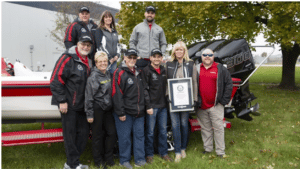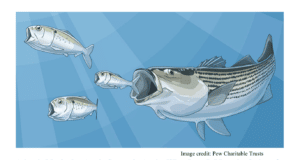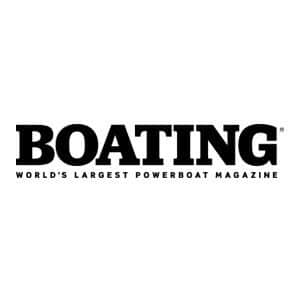IRAQ, somewhere South of Haditha Dam- The blue-green water of the Euphrates slips by at a healthy four knots as chirping from enemy AK-47s and the unmistakable thump of mortar rounds are heard in the distance. Insurgents lie in wait a few clicks from the green briar brush and palm fronds that line this part of the muddy bank. Now and then Black Hawk helicopters slice the night sky.
Downstream, two 35′ diesel-powered Riverine Assault Craft (RAC) are on patrol, the din of their engines barely audible at 1500 rpm. The depth of the Euphrates here, 150 miles northwest of Baghdad, is erratic-skinny water is everywhere. It’s a challenge just to keep the combat-loaded, 16,000-pound boats off the bottom. Even with the firepower of .50-cal machine guns sweeping the shoreline, this is no place to run aground.
Hadithah dam is a high-value target, a main source of hydroelectric energy for much of the country. The 2nd Marine Division’s Small Craft Company (SCC) is here to see that those turbines keep humming. The unit has been deployed almost from the beginning of operations in Iraq, taking part in waterborne recon, combat patrols, search-and-rescue missions, and island raids. As of this writing they’ve suffered no casualties, lost no lives. Luckily, tonight’s patrol goes off without a hitch. But there’s always tomorrow; after all, this is war.
BOAT CAMP
After the first few journalists were taken hostage, I thought twice about an assignment on the Euphrates. I decide it’s best to meet up with an SCC platoon on its home turf of Camp Lejeune, North Carolina, far from the desert heat and any rocket-propelled grenade with my name on it. I’m riding along to file a first-hand account of the boats and combat tactics in this newest phase of river warfare.
The three platoons of SCC are on rotation-six months on, six months off. The guys I’m training with are heading back to Iraq in two weeks.
The base is a sizable 153,439 acres nestled on the New River, a tributary not far from the Atlantic coast. My guide, Capt. Jeffrey Pool, meets me at the main gate where at 0900 there are already two news vans camped out looking for the day’s scoop. The press has been present at the base almost every day since the war began, says Capt. Pool. “One of the big CNN anchors-Paula Zahn, I think-was down here just last week.” I briefly content myself with the thought that she wasn’t up for the thick of battle either.
After being okayed by a heavily armed sentry, we pull into the parking lot that surrounds the newly finished SCC building. The stifling 90-plus temps don’t seem to be slowing down any of the double-timing marines in the yard. The only evidence that the earth is, in fact, baking, are rings of sweat on the shirts of the guys that boogie past. Meanwhile, I long for my air conditioner.
Down by the river, I get my first glimpse of the reason I’m here-the boats. For a split second, I imagine I’ve seen a ghost. Tied up against the concrete dock pilings are the dark-green RAC, which remind me of a past era, of another war-Vietnam. We’ve all seen the grainy news footage of Swift boats and PBRs (Patrol Boat, River) on the muddy waters of the Mekong. The RACs here are the next generation of those boats, sans pilothouse. At Camp Lejeune, the Brown Water Navy lives on. But it isn’t under the auspices of the Navy anymore.
“None of the other branches of the military wanted river patrol,” says Sergeant Scott Kocab, the coxswain assigned to teach me on-river maneuvers. And the jobs that nobody wants, the marines take-with enthusiasm. Hoo-rah!
DON’T TRY THIS AT HOME
Sitting in the RAC’s forward bucket seat, I briefly finger the .50-cal and reconsider my career choice-but only for a minute. “The first maneuver I’ll show you is the J-turn. Hold on,” instructs Kocab. Ten seconds later we hit our wide open speed of just under 40 knots. Suddenly, Kocab, as if playing some sick joke, cranks the wheel hardover. The boat whips to port and the stern skips around 180 degrees.
“That’s an evasive maneuver,” Kocab smiles as I peel myself off the console. “Would you like to try it again?” No, thanks.
Kocab’s next riverine assault on my fraying nerves is the death-stop. At full speed, he throws down the buckets of the Hamilton 271 jet drives, causing the bow to dig in and the boat to stop, but not before throwing a monster wave over the bow into the cockpit. Kocab seems pleased with the result. Slightly less extreme is the S-turn, done while wide open (are you noticing a pattern here?) using only the jet’s buckets-not the wheel-to make the snakelike turns.
One of the few maneuvers that isn’t done at full throttle is called the dolphin. We stop just shy of a channel marker, as Kocab uses the buckets to crab 360 degrees around, keeping the bow pointed at the marker. The usefulness of this drill isn’t apparent until you consider that the .50-cal is pointed directly ahead. A machine gun’s business end is a scary sight. “Containment,” grunts Kocab.
Sitting still isn’t something riverine marines often do; nonetheless they practice anchoring techniques-with an understandable emphasis on quick getaways. I was shown two strategies. First, we brought the boat close to shore, where we were able to tie to a tree-our own gigantic beach spike. Time to go? To hell with untying knots. Cut and run. Out comes the ax, the line splits, and we’re gone. The second method is to drop an anchor tied to a fender, then tie the boat to the fender. If a quick escape is needed, cut loose or untie from the fender, which marks the anchor when it’s safe to come back.
I beg off the demonstration of troop transfers, which consists of two RACs running side-by-side at full-throttle, their bows angled in, pushing against each other, allowing soldiers to jump from boat to boat. Make a mistake and one boat climbs over the other. These guys are either crazy or brave beyond my comprehension-or both.
IN LIKE FLEET
Back at the dock, I take a stroll through the other SCC boats. There’s a Rigid Raiding Craft (RRC) outfitted with twin 70-hp Johnsons. It’s easy to spot the familiar lines of an 18′ Boston Whaler, but get up close and it looks nothing like what I’ve seen while fishing. For one, it’s painted camo. There are no angling accouterments, no fishing package, and no ski pylon.
Uncluttered deck space is a must if it’s expected to haul 10 fully loaded troops. The helm is fastened to the deck with cotter pins for quick removal and service, and there’s a huge grabrail bolted outboard to aid boarding. The leaning post reaches only halfway up my legs-on a normal Whaler it would at least come up to my butt. As it turns out, it’s not built for butts, but for backs, “It’s for when you’re squatting down behind the helm to avoid enemy fire,” instructs Kocab. Makes sense.
The smallest boat is the CRRC (Combat Rubber Reconnaissance Craft), which is used for “over the horizon clandestine insertions.” It’s a 15’6″ inflatable, powered by a submersible (as in totally waterproof) 55-hp Johnson jet outboard. It can hold eight combat-equipped soldiers. I’m told that the hardest part of handling one of these is getting it upright after being flipped in the surf. Another demonstration that I’ll leave for a different day.
CONVOY
“Two is one, one is none” is an oft-repeated mantra, says Kocab. Soldiers are taught that one boat in a war zone is the same as having no boats. Platoons mostly travel in small fleets, using formations such as lined astern, diamond, or wedge-tailing close enough to hide how many boats there are to oncoming traffic. The Herringbone is another. The marines use it in case of an air assault. Running astern of one another, they wait until the enemy aircraft is within firing range. Then odd numbers turn hardover one way, even goes the other. This confuses the enemy long enough to return fire-they hope.
Standing onshore as the platoon readies for exercises, the commander asks if I want to ride along.
“What are you guys doing?” I ask.
“Insertions and extractions. We’re going to storm the beaches at dusk.”
I have an evening flight to catch, but briefly remember the feel of the big gun in my sweaty grip. I’m eager to cap off a few rounds. “When will you be back,” I ask the brass.
“When I’m satisfied,” he replies as he stands on the bow barking orders.
Since he won’t be satisfied anytime soon, I have to pass again. As the platoon heads out the inlet, it’s comforting to know that on the other side of the world the marines of Small Craft Company are on patrol…and that I’m not with them.
Top-Secret Launch
Military bigwigs estimate that 70 percent of future battlefields will be in urban areas. Most of these major population centers are based near a coastline or along a river. The new frontlines will be at the water’s edge, and new boats are needed for these challenges.
The answer? Small Unit Riverine Craft. I was at Camp Lejeune the day the SCC took delivery of the first two aluminum-hulled SURCs. They’ll replace the Rigid Riding Craft and eventually the Riverine Assault Craft. My assessment? The SURC continues the Marine tradition of no-nonsense warrior boats while looking ahead to the future.
Twin 440-bhp Yanmars linked to Hamilton HJ292 jet drives power the boat to 39 knots in less than 20 seconds. Handling is crisp and responsive-180-degree turns can be accomplished in less than one boat length. The high-strength, solid-cell polyethylene collar not only provides small-arm ballistic protection but stability and redundant buoyancy as well. A section of the forward bow is equipped with a hydraulic landing door for beach access. Don’t care for the aft seating arrangement? Well go ahead and toss the seats, they’re completely removable. One nod to comfort that I’m impressed with is the molded-in console footrest (seriously). Aluminum console sides should stop anything short of a rocket-propelled grenade.









